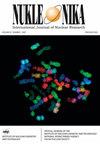独立验证处理计划系统计算
IF 0.3
4区 物理与天体物理
Q4 CHEMISTRY, INORGANIC & NUCLEAR
引用次数: 2
摘要
摘要目的根据现有的国际建议,每个接受远程放射治疗的患者至少需要一个独立的监测单元数(MU)计算验证。本研究的目的是估计两种治疗计划系统:Eclipse (Varian)和Oncentra MasterPlan (Elekta)计算出的剂量分布的差异。材料与方法对280个瓦里安加速器光子束流三维适形放疗方案进行了分析:CL 600C/D X6 MV(109个方案)、CL 2300C/D X6 MV(43个方案)和CL 2300C/D X15 MV(128个方案)。采用Wilcoxon配对对符号秩检验比较Eclipse和Oncentra MasterPlan (OMP)获得的计划靶体积(PTV)平均剂量和等中心点剂量。此外,将治疗计划系统(TPS)计算结果与在非均匀模型中进行的剂量学测量结果进行比较。结果分别分析了6 MV方案和15 MV方案的数据,独立于治疗机。Eclipse计算的剂量值显著高于OMP系统计算的剂量值(p <0.001)。对PTV的平均剂量差值X6 MV为(1.4±1.0)%,X15 MV为(2.5±0.6)%。X6 MV和X15 MV等中心点的平均剂量差分别为(1.3±1.9)%和(2.1±1.0)%。最大的差异出现在肺、空腔和骨结构上。此外,与Eclipse计算相比,剂量测量的变化更小。结论引入OMP计算作为独立的MU验证工具,第一作用水平范围为3.5%。本文章由计算机程序翻译,如有差异,请以英文原文为准。
Independent verification of treatment planning system calculations
Abstract Purpose According to the available international recommendations, at least one independent verification of the calculations of number of monitor unit (MU) is required for every patient treated by teleradiotherapy. The aim of this study was to estimate the differences of dose distributions calculated with two treatment planning systems: Eclipse (Varian) and Oncentra MasterPlan (Elekta). Materials and methods The analysis was performed for 280 three-dimensional conformal radiotherapy treatment (3D-CRT) plans with photon beams from Varian accelerators: CL 600C/D X6 MV (109 plans), CL 2300C/D X6 MV (43 plans), and CL 2300C/D X15 MV (128 plans). The mean doses in the planning target volume (PTV) and doses at the isocenter point obtained with Eclipse and Oncentra MasterPlan (OMP) were compared with Wilcoxon matched-pairs signed rank test. Additionally, the treatment planning system (TPS) calculations were compared with dosimetric measurements performed in the inhomogeneous phantom. Results Data were analysed for 6 MV plans and for 15 MV plans separately, independently of the treatment machine. The dose values calculated in Eclipse were significantly (p <0.001) higher compared to calculations of OMP system. The average difference of the mean dose to PTV was (1.4 ± 1.0)% for X6 MV and (2.5 ± 0.6)% for X15 MV. Average dose disparities at the isocenter point were (1.3 ± 1.9)% and (2.1 ± 1.0)% for X6 MV and X15 MV beams, respectively. The largest differences were observed in lungs, air cavities, and bone structures. Moreover the variation in dosimetric measurements was less as compared to Eclipse calculations. Conclusions OMP calculations were introduced as the independent MU verification tool with the first action level range equal to 3.5%.
求助全文
通过发布文献求助,成功后即可免费获取论文全文。
去求助
来源期刊

Nukleonika
物理-无机化学与核化学
CiteScore
2.00
自引率
0.00%
发文量
5
审稿时长
4-8 weeks
期刊介绍:
"Nukleonika" is an international peer-reviewed, scientific journal publishing original top quality papers on fundamental, experimental, applied and theoretical aspects of nuclear sciences.
The fields of research include:
radiochemistry, radiation measurements, application of radionuclides in various branches of science and technology, chemistry of f-block elements, radiation chemistry, radiation physics, activation analysis, nuclear medicine, radiobiology, radiation safety, nuclear industrial electronics, environmental protection, radioactive wastes, nuclear technologies in material and process engineering, radioisotope diagnostic methods of engineering objects, nuclear physics, nuclear reactors and nuclear power, reactor physics, nuclear safety, fuel cycle, reactor calculations, nuclear chemical engineering, nuclear fusion, plasma physics etc.
 求助内容:
求助内容: 应助结果提醒方式:
应助结果提醒方式:


